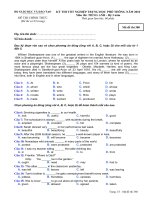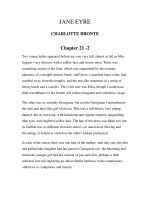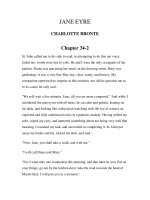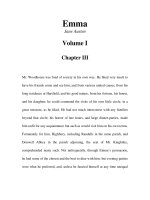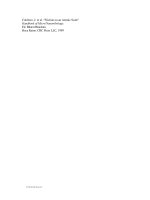Tài liệu Improving Fourth Grade Students’ Writing Skills With 6+1 Traits of Writing and Writer’s Workshop ppt
Bạn đang xem bản rút gọn của tài liệu. Xem và tải ngay bản đầy đủ của tài liệu tại đây (2.67 MB, 41 trang )
Improving Fourth Grade Students’
Writing Skills With 6+1 Traits of
Writing and Writer’s Workshop
Jessica L. Flyte-Rettler
Spring 2004
Elem Ed 720 Action Research in Curriculum & Instruction
and
Elem Ed 792 Seminar in Curriculum & Instruction
Dr. Judith Hankes
1
Improving Fourth Grade Students’ Writing Skills
With 6+1 Traits of Writing, Graphic Organizers,
and Writer’s Workshop
Jessica L. Flyte-Rettler
A Seminar Paper Submitted in Partial
Fulfillment of the Requirements for
The Degree of
Master of Science in Education
Curriculum and Instruction
University of Wisconsin Oshkosh
Oshkosh, Wisconsin 54901-8621
May 2004
Approval Date
First Reader: _________________________________________ ________________
Judith Hankes, Ph. D.
Second Reader: ______________________________________
_________________
Shawn Jepson, Master of Education and
Administration
2
TABLE OF CONTENTS
ABSTRACT 4
STUDY SEQUENCE 5
STATEMENT OF THE PROBLEM 7
SITUATING THE PROBLEM 7
LITERATURE REVIEW 9
Traditional Writing Instruction 9
Writer’s Workshop 10
6+1 Traits of Writing 12
Just the Right Mix 13
METHODS 14
Participants 14
Data Collection 14
Methods of Data Analysis 14
Intervention 15
RESULTS OF DATA ANALYSIS 20
CONCLUSIONS 25
FUTURE PLANS 26
REFERENCES 28
APPENDIX A 30
APPENDIX B 33
APPENDIX C 36
APPENDIX D 37
APPENDIX E 38
APPENDIX F 39
APPENDIX G 40
3
Abstract
This study explores the implementation of two contemporary approaches to
teaching writing, Writer’s Workshop and 6+1 Traits of Writing. The purpose of the study
was to help fourth grade students become proficient writers both in their descriptive
writing content and in their written mechanics. The study also compares the transfer of
written skills using these approaches versus the commonly taught Daily Oral Language
process and grammatical textbook activities.
Throughout the study, students were actively involved in many hands-on writing
activities. The lessons encouraged students to engage in discussions about their
writing, as opposed to completing textbook based activities and lessons without student
interaction. While traditional writing concepts were still being covered, the manner in
which they were delivered and applied was much different.
The outcomes of this study indicate students’ active participation in writing
lessons improves their writing skills. The data also suggests that students’ abilities to
write more descriptively dramatically improved when the lessons focused on the specific
6+1 Trait known as word choice.
4
STUDY SEQUENCE
July
-Investigated potential action research topics
-Identified an area in need of improvement: writing instruction
-Finalized the research question
-Developed Statement of the Problem
-Began research for the Literature Review
August
-Continued research for the Literature Review
-Began Situating the Problem
-Began writing Literature Review
-Researched lesson ideas
September
-Changed focus of the Literature Review
-Continued research for the Literature Review
-Continued writing Literature Review
-Continued Situating the Problem
-Collected baseline writing sample
-Researched lesson ideas
-Purchased books with lesson ideas
October
-Continued research for the Literature Review
-Continued writing Literature Review
-Finalized Situating the Problem
-Continued researching lesson ideas
-Gathered materials from the public library for the intervention
-Searched for possible journals for research paper submission
-Began implementing the intervention
-Kept a journal about the intervention
-Calculated and documented information from the pre-baseline writing sample
November
-Began writing the methods portion of the paper
-Continued implementing the intervention
-Continued journaling about the intervention
-Concluded the intervention portion of the project
-Continued writing the intervention
December
-Attended the Rebecca Sitton Conference on improving spelling in students’ writing
-Finalized method portion of the paper
-Collected the post-baseline writing sample
5
-Calculated and documented the results from the post-baseline writing sample
-Continued writing the intervention
-Scanned lessons, samples, and materials
-Began writing the results of data analysis
-Drafted conclusions and future plans
January
-Began writing the conclusion and future plans
-Finalized writing the intervention
-Continued writing the results of data analysis
-Created graphs to show project results
-Updated references to include intervention materials
-Created cover and signature pages
-Revised all sections of the research paper
February
-Revised all sections of the research paper
March
-Revised all sections of the research paper
-Wrote abstract
April
-Finalized all sections of the research paper
-Assembled all parts of the paper including Table of Contents and Appendixes, and
References
-Created a poster presentation
May
-Submitted final paper
-Displayed poster presentation
6
STATEMENT OF THE PROBLEM
Writing is the most dreaded activity for my fourth grade students. Not only do
they strongly oppose writing in all forms, they struggle to use the proper mechanics to
communicate effectively with a targeted audience. My frustration with my students’
abilities to be effective writers led me to investigate the following question: “Will the
implementation of selected lessons and activities taken from 6+1 Traits of Writing and
Writer’s Workshop equip my students with the descriptive and mechanical writing skills
they need to become proficient writers?”
SITUATING THE PROBLEM
In May of 2000, I graduated with an undergraduate degree in elementary
education and a minor in English as a Second Language. My first teaching position was
in a rural school district. I taught fourth through eighth grade bilingual classes, two
sections of seventh and eighth grade Spanish, and worked with several at-risk students.
Frustrated by the educational gains these students made, and the lack of respect for
bilingual education, I applied and was hired for my current fourth grade position in a
neighboring school district. After seeing many problems in students’ ability to transfer
written English skills into their daily writing in each of the school districts in which I had
taught, I was inclined to study methods and strategies that would improve their writing
skills.
The study reported in this paper was conducted during my third year of teaching
fourth grade and the fourth year of my teaching career. The study site was my fourth
grade classroom in a K-12 school, located within an agricultural community. The
7
school’s population, approximately 850 students, consisted of lower and middle class
students. The school also had a large number of migratory and settled Hispanic
families. It is important to note, more than fifty percent of the students in this school
district received free or reduced lunch, therefore this school qualified as a Student
Achievement Guarantee in Education (SAGE) School.
During the year of this study, I taught three sections of English with a total of 61
students. A wide range of my students’ abilities and the presence of English Language
Learners (ELL) in my classroom presented me with many challenges. Components of
my instruction included the Houghton-Mifflin textbook series, Daily Oral Language,
traditional grammar activities, and other supplemental materials. After several weeks of
instruction I was disappointed in my students’ inability to demonstrate proper writing
skills. It was apparent the typical routine of completing daily oral language and
grammar lessons was not beneficial; students had difficulty seeing the relevance.
My daily instruction routine included having students correct two Daily Oral
Language sentences at their desks. After completion of this task, student volunteers
made corrections on a transparency that was projected on a screen for the class to see.
Each student explained his or her corrections to the class and the class proposed
additional corrections as deemed necessary. Students then completed a language
lesson, such as copying sentences from the textbook and identifying the subject and the
predicate.
On Fridays, we had a designated block of time for writing. Writing topics
included teacher selected topics, journal writing, field trip or special project reflection,
and theme writing. Typically, when I announced to the students they needed to take out
8
their journal and a pencil, the groans began. The students openly stated that they
preferred other school topics. To my dismay, students routinely asked, “How many
sentences do we have to write in each paragraph? How long does this have to be? Is
this good enough? Do we have to write in cursive, or can we print?” I even encouraged
them to illustrate their writing, but for some students this added drudgery to the
assignment.
Scoring these written pieces was disappointing and difficult for me. The students
were not transferring skills from the Daily Oral Language and grammar lessons. As a
professional, I began questioning my methods for teaching writing. I could not
understand why students were not applying the isolated skills they had been taught and
had practiced into their writing. After many recurring instances, I asked my frustrated
self, “What is the problem here? How can it be resolved?” I knew I had to teach
differently, but how? To answer these questions, I completed a review of literature to
determine what experts in the field of teaching recommended.
LITERATURE REVIEW
Traditional Writing Instruction
Many techniques have been used to improve student writing. Researchers
report that students should have ample time to write at least four times a week,
regardless of the type of writing program. According to Tina Robertson, teachers are
individuals with different beliefs, techniques, and expectations. There is not one exact
way to teach a program (Solley, 2000). In a book written by Allington and Walmsley, No
Quick Fix: Rethinking Literacy in America’s Elementary Schools, there are no instant or
prescriptive solutions to improve literacy instruction for all children (Sims, 2001, p. 21).
9
Harris and Graham also noted, there is not a method proven to meet every child’s
learning style. “Teachers should use instructional methods grounded in their individual
philosophies about teaching writing” (Pollington, Wilcox, and Morrison, 2001, p. 262).
Traditional writing instruction is teacher-controlled, driven by grammar and
conventions, and instruction follows a textbook and worksheet model (Pollington et al.,
2001, p. 250). Instruction is typically conducted in a whole class setting, and is rarely
integrated with other curriculums. Pollington et al., (p. 257) also noted that traditional
instruction is conducted in a “lock-step manner,” where “Students were generally all
kept at the same stage in the writing process.” Written pieces are usually intended for
the teacher and turn into a form of assessment rather than a learning experience
(Pollington et al., p. 252).
Another concern of traditional writing instruction is students’ inability to transfer
skills taught in isolation. Experts warn that Daily Oral Language and traditional textbook
instruction can be the demise of student creativity, thus causing students to have a
disinterest in writing (Pollington et al., 2001, p. 252).
Writer’s Workshop
Writer’s Workshop incorporates a variety of strategies that gives students
ownership of their writing, while learning the important writing skills. Often times,
teachers avoid Writer’s Workshop, because they fear classroom chaos.
I did not know how to share responsibility with my students, and I was not too
sure I wanted to. I like the vantage of my big desk. I liked being creative, setting
topic and pace and mode, orchestrating THE process, taking charge (Atwell,
1998, p. 13).
By affording students the opportunity to choose their topic and genre, Atwell (1998, p.
15) discovered that students’ written skills leaped to a completely new level.
10
Researchers agree that student writers need “regular assigned periods of time
when writing is done, suggested as well as original subjects for writing, time when
mechanics are taught within the context of the assignment, good adult writing models to
use as a guide and time to read as well as write” (Adams et al., 1996, p. 17).
Enthusiastic modeling by the teacher is contagious to students (Olbrych, 2001, p. 11).
Teachers need extensive training in order to be successful at teaching writing according
to Graves (Jackson, 1996, p. 8). Following the training, teachers must demonstrate the
new technique for the class. As students show gains, the transfer or the ‘hand-over
phase‘, termed by Jerome Bruner is evident. This is a time “when an adult intervenes
and gradually provides less assistance to a learner” (Atwell, 1998, pp. 19-20).
A main component of the Writer’s Workshop is a twenty-minute interactive mini-
lesson (Atwell, 1998, p. 151). Atwell defines a mini-lesson as “brief lectures at the start
of class about procedures, conventions, craft, genre, and topic development” (p.15).
Most often, mini-lessons are conducted as an entire group. However, there are times
when small groups of students need specific instruction and Atwell encourages these
small group teachings. She also stated, “Mini-lessons reach more than one writer at a
time, provide frames of reference when writers and I confer, and grow from what I see
my students doing, not doing, and needing next” (Atwell, 1998, p. 24).
Atwell (1998) has students join together in a circle to share aspects of their
writing as a post-writing session mini-lesson.
Today I’ll ask you to listen to leads. The lead of a piece of writing is its
introduction. The lead section is probably the most important. It sets the tone
and subject, introduces the style, and establishes the voice. Would you look at
your draft-in-progress and lightly mark with your pencil what you consider your
lead—the sentences or paragraphs that introduce your piece?
11
Now, would you read your lead, one right after another, around the circle?
There’s no discussion today no critiques or congratulations. Let’s just listen to
and absorb what the writers in this group are doing. Watch the face of each
writer as we go around the circle and listen to what he or she tells. (pp. 143-144).
Atwell summarizes the ideas for all of the students and uses this session as a
conclusion to Writer’s Workshop.
Students maintain a folder for written pieces that are unfinished, unedited, or
have not gone through the final publishing phase. Once a piece has been published
and presented to the targeted audience it is placed in a portfolio (Atwell, 1998, pp301-
302). Atwell (1998) recommends that students write a self-evaluation of the piece and
include it in the portfolio. This portfolio is another organizational tool used by
participants in the Writer’s Workshop (Atwell, 1998). Adams (1996) states “A portfolio is
very useful to a teacher because it is a collection of student work that reflects the
students’ efforts and progress.” Burke adds, “A portfolio contains several separate
pieces that may not mean much by themselves, but when compiled together, they
produce a more accurate and holistic portrait of the student (Adams, 1996, p 20).
6+1 Traits of Writing
6+1 Traits of Writing “is a vocabulary teachers use to describe their vision of what
good writing looks like” (Culham, 2003, p. 7). It is also a model for assessing student
writing. Culham’s book gives an in-depth explanation of the 6+1 traits: ideas,
organization, voice, word choice, sentence fluency, conventions, and presentation and
explains the advantages of using the trait-based writing model (Culham, 2003, pp. 11-
14). “As students learn the traits, they find that the first five deal with revision, the last
two with editing” (Scholastic Instructor, Oct. 2003, p. 14). She also designates a
chapter for each trait in which she shares writing samples, explicit lessons and activities
12
that can be conducted with a class, and writing assessment rubrics (Culham, 2003, pp.
33-260).
The 6+1 Traits of Writing Rubrics shift the focus from traditional instruction and
letter grade assessment to improving writing skills and providing specific feedback on
the student’s work, instead of the final project (Scholastic Instructor, Oct. 2003, p. 14).
The rubrics provide the students with specific criteria of achievement by taking the
guess work out of assessment and providing a clear explanation of why the student
received the letter grade they did (Culham, 2003, p. 10).
Just the Right Mix
Culham (2003) reiterated the point of many researchers when she stated “The
traits are flexible and should be a cornerstone of your writing program, but they alone
aren’t the whole package” (p. 19). Writer’s Workshop is a format for teaching writing
and 6+1 Traits of Writing are most effective when taught as mini-lessons. The 6+1
Traits of Writing rubrics can play an integral part in assessing student’s writing within the
Workshop (James et al., 2001, pp. 31-33).
James, Abbott, and Greenwood (2001) reported in their article, How Adam
Became a Writer: Winning Writing Strategies for Low-Achieving Students, teachers
used strategies from the Writer’s Workshop and 6+1 Traits of Writing to help all students
achieve their highest writing potential. Graham and Harris noted several drawbacks
with the Writer’s Workshop that makes success difficult for students with learning
disabilities. Writer’s Workshop uses an implicit form of instruction, where skills are
taught as the need arises instead of direct instruction “around a sequence of skills”
(James, et al., 2001, pp. 31-34).
13
My review of literature indicates the “melding” of 6+1 Traits of Writing and
Writer’s Workshop models will improve students’ writing skills and attitudes (James, et
al., 2001, p. 34). This approach will be the major theme behind my class action
research project.
METHODS
Participants
During the year this study was conducted, I taught English to 61 fourth grade
students. Eighteen of those fourth graders were the target participants in this study.
These students were selected from three separate sections of English class, six
students from each class. Student selection was based on writing ability as
demonstrated by achievement test scores and grade level performance. Two students
from each of the high, middle, and low ability groups were selected.
Data Collection
Two methods of data collection were used in this study. Pre- and post-
intervention data was collected using a creative writing piece (see Appendix B and
Appendix G). As a pre-intervention assignment, students were given a lined piece of
paper with the words “Late One Night…” at the top of the page. They were asked to
continue the story based on personal experiences or make believe events. For the
post-intervention assignment, students continued the story that began “Early One
Morning…”
Methods of Data Analysis
Each pre- and post- writing intervention sample was assessed for its descriptive
and mechanical writing components. Descriptive writing was analyzed by comparing
14
the number of times students used an adjective or an adverb with the total number of
words in each piece. I then divided the total number of written words by the total
number of adjectives and adverbs to calculate a percentage. I counted the total number
of words in the piece instead of the total number of sentences, as to ensure I was only
calculating the percentage of descriptive words, not sentences.
Mechanics of each sample were also analyzed. I tallied the number of
punctuation, spelling, grammatical, and capitalization errors and then divided the total
number of errors by the total number of words and determined the number of errors per
word for each student.
Intervention
The intervention was conducted over a five week period. Due to interruptions
caused by state standardized testing, it is difficult to explain the intervention in the exact
sequence it was delivered. I have, however, highlighted the important lessons and
activities I conducted.
Lesson One
We began the intervention by exploring writing topics and characters. Each class
read aloud and discussed Amelia’s Notebook, (Moss, 1995), a journal written and
illustrated from the point of view of an upper elementary student. I used this journal as
an introduction to writing. In the past, students had great difficulty choosing a topic for
journaling, so I required each student to keep a list of writing topics. This list was
adapted from the “Writing Territory List” titled and defined by Atwell in her book Writer’s
Workshop (see Appendix A). I modeled the ‘quick write’ brainstorming activity for the
students by listing writing topic that came to mind during a one minute time period.
15
Examples from my list were as follows: house, trip to Florida, husband, family,
vegetable farm, niece and nephew, horses, 4-H, among others. Students listed their
ideas for five minutes and shared several topics from their list. During the sharing
process, students added topics as they came to mind, even if it was another person’s
idea. Using the same process, a list of characters was created. Students were advised
to refer to this list when they were having difficulty identifying a topic or characters to
begin the self-selected writing assignments. Students were encouraged to add to the
topic list and character list throughout the intervention.
Creativity: Detail, Fluency, and Originality
To clarify the meaning of creativity, students were directed to add details to
partial drawings on the blackboard that lacked detail: a drawing of a person wearing a
skirt and T-shirt, a person wearing jeans and a T-shirt, and a landscape horizon with a
fading roadway. Students came to the board one by one and added a detail to the
drawing (see Appendix C). The concluding discussion defined for students the
components of creativity: originality, fluency, and detail. We discussed the
implementation of these concepts into our future writing pieces to achieve the same
results we experienced in this drawing activity.
Defining Adjectives and Adverbs
Next, I used the books What Is an Adjective? and What Is an Adverb? (Cleary,
2000) to teach students about adjectives and adverbs. After reading each book,
students were directed to write a list of adjectives and adverbs in their English journals.
This activity defined the function of adjectives and adverbs, demonstrated appropriate
usage, and raised students’ awareness of exciting words they may incorporate into their
16
writing.
More Adjectives and Adverbs
Then, I read aloud Toad (Brown, 1997). This picture book gave students a visual
and literary representation of how the use of adjectives and adverbs (see Appendix C)
produces outstanding writing that intrigues audiences of all ages. Again, after hearing
this story, students added adjectives and adverbs to their journal lists started in the
previous lesson.
Overused Words
After reading the story, Toad, I focused my next lesson on reducing the number
of overused words. I read aloud Stellaluna (Cannon, 1993). Students identified words
that had strong and weak characteristics as defined by 6+1 Traits. Students
brainstormed uneventful, overused words and we listed them on the whiteboard.
Drawing on a lesson from Writer’s Workshop, I drew a two column chart on a large
sheet of paper and labeled one column ‘Salsa’ and the other column ‘Rice Cake.’ We
discussed the meaning of each title and then categorized each word into one of the two
categories (see Appendix D). Students then copied the chart into their English journals.
They were encouraged to use the ‘salsa’ words in future writing assignments; however,
they were no longer able to use the ‘rice cake’ words in their writing. As an extension of
this lesson, students chose a word from the ‘rice cake’ column, looked it up in a
thesaurus, and wrote alternative ‘salsa words’.
More Overused Words
As a follow-up to the previous activity, we continued our quest of using vibrant
words, instead of the overused, redundant words. This activity was adapted from the
17
lesson, “Using Vibrant Words” (Appendix E). During this activity, students were placed
into groups of four. Each group was given an index card with a verb written on it. Their
task was to brainstorm as many adverbs and alternative verbs as they could within
three minutes and then demonstrate their words for the class. For example, the card
one group received said ‘walk’, so students walked around the room slowly, quickly,
quietly, and loudly. They also trudged, sauntered, and meandered. Each group was
then given a noun and had to describe the noun with great detail. For example, the
card said, ‘house’. Students described their word as being large, purple, ancient, a
mansion, tiny, crackerjack box sized, among other descriptive words. This activity
provided students with yet another opportunity to expand their lists of adjectives and
adverbs and to replace previously overused words.
Using Your Senses to Improve Your Writing
“What Do Your Senses Tell You?” was a lesson that ranked high with students.
During the activity, students were divided into groups and then rotated through five
sensory stations. They experienced adjectives and adverbs in a very tactile manner
and noted their experiences at each station in their English journals (see Appendix F).
After experiencing these stations, students wrote a paragraph explaining how sensory
information helped them become descriptive writers. As a conclusion to this activity,
student volunteers read aloud their paragraphs.
Expanding Sentences
Having had an abundance of experiences with adjectives and adverbs, we began
writing sentences. Each student wrote a simple, non-descriptive sentence. For
example, “The dog sat.” Students were directed to pass their paper to the person
18
seated behind them who added one detail to the sentence. The sentence became,
“The yellow dog sat.” Papers continued to be passed until all were returned to the
original author. Finally, student volunteers shared the transformation of their sentence
with the class.
Photo Description
For the final writing lesson, students brought in a picture from home. They
drafted a paragraph describing their photo in great detail. Students were encouraged to
paint this picture in the reader’s mind as opposed to telling which photo they were
describing.
One student painted the photo for the reader by writing, “This is a picture taken
late in August at a very popular county event. I am in a show ring with many other 4-H
members, and we are demonstrating our showmanship ability. There are many people,
including my parents, watching and waiting to see what the placing will be. What
picture am I?” Another student described the same picture by writing, “This is a picture
taken at the county fair. I am showing pigs in a show ring. What picture am I?” The
first sample exemplifies ’showing’ and the second sample exemplifies ’telling’. This was
discussed with students.
After students drafted the paragraph, they read it aloud to a partner. Then, they
read it again while their partner simultaneously illustrated what their mind’s eye saw. If
the drawing closely matched the student’s picture, the students edited the paragraph for
grammatical, spelling, and punctuation errors. If the drawing did not match the picture,
the partners worked together to improve the paragraph with my direct mentoring. When
the editing phase was complete, students wrote the final copy.
19
Lastly, each section was given a paragraph from another English class. With all
of the pictures posted at the front of the room, students read the paragraph and then
matched it to the picture that was described.
Finally, after five weeks of instruction, my writing intervention ended and I
assessed the students to determine its effectiveness.
RESULTS OF DATA ANALYSIS
The pre- and post-intervention writing samples were obtained from eighteen
fourth grade students. The pre-intervention writing sample was titled, “Late One
Evening,” and the post-intervention writing sample was titled, “Early One Morning.”
The percentage of adjective and adverb usage in the studied group of high ability
students ranged from a 2.2 % to a 14.4 % increase of descriptive words in a sample. All
six of the students in this focus group showed improvement.
Five out of the six students in the middle ability group showed improvement. The
range of improvement for these five students was 2.6 % to 16 %. (The student who did
not show improvement from the pre-intervention writing sample to the post-intervention
writing sample scored a 16.2 % on the pre-intervention. While this student did not show
improvement, this score fell within the range of scores all eighteen students received on
the post-intervention writing sample. It is important to note the percentage was the
second highest on the pre-intervention sample and significantly higher than the majority
of percentages.)
All six of the student percentages in the low ability group showed significant
improvement ranging from 5.1 % to 17.1 %. The summary of the results are recorded in
the graphs and charts below.
20
Descriptive Writing Results
High Ability Group
0.00%
5.00%
10.00%
15.00%
20.00%
25.00%
High A High B High C High D High E High F
Pre-Intervention
Post-Intervention
Percentage of Descriptive Words
High A High B High C High D High E High F
Pre-Intervention
2.50% 2.30% 11.20% 7.80% 12.10%20.70%
Post-Intervention
13.90% 13.90%15.80% 22.20
%
19.80% 22.90%
Percent Increase in Frequency of Descriptive Word Occurrence
High A High B High C High D High E High F
Percent Increase 11.40% 11.60% 4.60% 14.40% 7.70% 2.20%
21
Descriptive Writing Results
Middle Ability Group
0.00%
5.00%
10.00%
15.00%
20.00%
Middle A Middle B Middle C Middle D Middle E Middle F
Pre-Intervention
Post-Intervention
Percentage of Descriptive Words
Middle A Middle B Middle C Middle D Middle E Middle F
Pre-Intervention 1.80% 13.50% 6.70% 16.20% 2.10% 2.30%
Post-Intervention8.00% 15.60% 15.50% 13.80% 18.10% 13.50%
Percent Increase in Frequency of Descriptive Word Occurrence
Middle A Middle B Middle C Middle D Middle E Middle F
Percent Increase 6.20% 2.60% 8.80% -2.40% 16.00% 11.20%
22
Descriptive Writing Results
Low Ability Group
0.00%
5.00%
10.00%
15.00%
20.00%
Low A Low B Low C Low D Low E Low F
Pre-Intervention
Post-Intervention
Percentage of Descriptive Words
Low A Low B Low C Low D Low E Low F
Pre-Intervention 8.90% 3.60% 4.40% 3.50% 2.90% 2.00%
Post-Intervention14.00% 14.10% 15.30% 16.20% 20.00% 11.50%
Percent Increase in Frequency of Descriptive Word Occurrence
Middle A Middle B Middle C Middle D Middle E Middle F
Percent Increase 6.20% 2.60% 8.80% -2.40% 16.00% 11.20%
Each sample was also analyzed for mechanics, which included spelling,
punctuation, capitalization, and grammatical errors. In the high ability group, student
mechanical errors per word ranged from .05 to .16 on the pre-intervention writing
sample. Five out of the six students showed improvement on the post-intervention
writing sample, where the range of errors per word was .03 to .15. In the middle ability
group, the range of errors per word was .07 to .23 on the pre-intervention sample and
.04 to .18 on the post-intervention sample. Four out of the six students showed
improvement from the pre- to the post-intervention. Lastly, the students in the low
23
ability group had a range of .10 to .30 errors per word on the pre-intervention sample
and a range of .09 to .29 errors per word on the post-intervention sample. Like the
middle ability group, four out of the six students in this group improved from the pre- to
the post-intervention writing sample.
Mechanics
STUDENT PRE-INTERVENTION
ERRORS PER WORD
POST-INTERVENTION
ERRORS PER WORD
H1 0.09 0.12
H2 0.16 0.15
H3 0.14 0.11
H4 0.11 0.04
H5 0.05 0.03
H6 0.07 0.06
M1 0.16 0.05
M2 0.14 0.10
M3 0.07 0.14
M4 0.23 0.05
M5 0.09 0.04
M6 0.17 0.18
L1 0.30 0.16
L2 0.10 0.09
24
L3 0.20 0.14
L4 0.22 0.10
L5 0.21 0.23
L6 0.26 0.29
CONCLUSIONS
This study proved traditional writing and grammar instruction are in need of
revision (Pollington et al., 2001). While most professionals would agree there is not one
prescribed method or philosophy to improve students’ writing skills, there are an
unlimited amount of resources to aid students in becoming proficient writers (Sims,
2001). As proven in this study, lesson ideas and instructional methods taken from
Writer’s Workshop and 6+1 Traits of Writing improved the transfer of skills into students’
writing (James, et al., 2001).
As I implemented lessons and activities, and shared suggested literature from
the 6+1 Traits of Writing, I found a renewed vigor in students’ desire to learn. The
plethora of lesson ideas challenged me to deliver the lessons enthusiastically and
effectively (Olbrych, 2001). I discovered the trait I implemented was “flexible” and I
experienced first-hand Culham’s statement that the traits should be the “cornerstone” of
one’s writing program (Culham, 2003).
The majority of students showed improvement in their written mechanics. While
very little of the instruction during this study focused on mechanics, student were given
25
